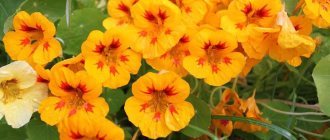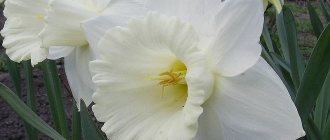Author: Tamara Altova. 01 September 2018
Category: Garden plants.
Cineraria (lat. Cineraria) is a genus of herbaceous flowering plants of the Compositae, or Asteraceae, family, close to the genus Raspberry (lat. Senecio), which includes some garden cineraria. Most often, the cineraria flower is found in Madagascar and tropical areas of Africa. There are about 50 species in the genus Cineraria (from Latin this word means “ashen”), and the genus Krestovnik has more than a thousand plants. We will tell you about those cineraria and ragworts that are more widely used in amateur gardening than other representatives of these genera.
Cineraria flowers - description
Cineraria in natural conditions are perennial or biennial plants, but in culture they are grown as annuals. These plants have a highly branched stem ranging from 30 to 90 cm in height. The petiolate, pinnately dissected, oval or lyre-shaped leaves forming a basal rosette are quite large in size, while the stem leaves are much smaller. Both the leaves and stems of the plant are heavily pubescent, which is why they look like they are covered with felt. The basket inflorescences, single or double, form terminal corymbose inflorescences and consist of tubular central yellow flowers, while the ligulate flowers can be white, purple or red. The cineraria plant blooms from June until frost.
Pest and disease control
Cineraria is known for its stable immunity, thanks to which it is almost not afraid of parasites and pests. Most problems begin due to improper care, which can be easily corrected.
Do not overwater the soil, otherwise the flower may begin to rot and rust will appear on the leaves. Wet fluffy sheets are an ideal environment for powdery mildew. In these cases, it is almost impossible to cure the damaged plant, and it is better to get rid of it before the disease spreads further.
Rarely do spider mites or aphids settle on cineraria. In this case, you will need insecticides or homemade solutions of nettles and soap. If a whitefly has settled in your garden, the mechanism for fighting it is exactly the same.
Cineraria has wilted - what to do?
Indoor cineraria is a favorite treat for many pests, including fungi; its susceptibility to disease is one of the reasons why many prefer not to replant it. If you see that indoor cineraria has wilted, it is most likely infested with pests.
Among numerous diseases, the flower is very susceptible to the following:
- Gray rot.
Infection with rot is possible if water often gets on the stems and leaves during watering. The flower is replanted and treated with special anti-rot preparations, the affected shoots are removed. - Alternaria.
The main symptom is light brown spots with a dark border that appear on the leaves. Diseases such as rust and oidium have similar symptoms. They are treated with fungicides. - Pests
– aphids, whiteflies, butterflies. This problem is easiest to recognize; insecticides are used for treatment.
If you notice that indoor cineraria has wilted, first try to identify the disease and begin appropriate treatment. But the problem is that the flower is very unstable to diseases - you need to act very quickly, literally on the same day you discover that not everything is in order with the plant. If you delay starting treatment, there is a high risk of losing the flower.
Growing cineraria from seeds
Sowing cineraria for seedlings
Typically, cineraria is propagated by seeds, which can be purchased at a garden pavilion or a specialty store. Seed germination rate is quite high. When to sow cineraria for seedlings? Sowing is done at the end of March or at the beginning of April. The seeds are laid out on the surface of a moist substrate consisting of equal parts of sand and peat, without covering them, lightly pressed with a wooden plank or ruler, sprayed with water from a spray bottle, covered with glass or film and placed in a warm place.
Caring for cineraria seedlings
Shoots will begin to appear within 7-10 days, and the container is immediately moved to the lightest windowsill, protecting the sprouts from direct sunlight. At the stage of development of two true leaves, the seedlings are taken out of the substrate along with a clod of earth and planted in separate containers. For picking, it is better to use peat pots: you do not have to disturb the root system of seedlings when transplanting them into open ground, since you can plant them in a flowerbed without removing them from the peat container.
Methods for propagating cineraria
For elegant flowering modifications of cineraria, growing from seeds (photo above), as a method of propagation, is best suited. Other species can be propagated by cuttings or dividing the bush.
Cineraria - growing from seeds
Cuttings are not suitable for every species. Cineraria maritime responds well to the use of this propagation method.
Cuttings are carried out in the summer season, when the survival rate of the material is high:
- cut 10 cm of the apical shoot;
- the cut is treated with root for rapid root growth;
- shoots with sprouted roots are placed in boxes with sand and peat in equal proportions;
- cover the seedlings with transparent plastic bottles or film so that the cuttings take root more easily;
- the covering material is removed gradually when roots form, increasing the ventilation time daily;
- The cuttings are wintered in containers in a cool room;
- with the onset of spring warmth, overwintered cuttings move to a permanent place of residence.
Dividing the bush according to the recommendations of experienced gardeners is carried out before flowering time. The plant is carefully removed from the soil. The bush is divided with the condition that a good root network is left on each new plant. The place where the piece of root is cut is sprinkled with wood ash. But this method is used in rare cases. Dividing the bush is most suitable for silver cineraria.
Cineraria - propagation by cuttings
Cineraria indoors does not stop growing in winter, but some of its shoots may become too long; with their help, we can propagate by cuttings. Young shoots are carefully cut off, treated with rooting preparations and immediately planted in a prepared pot with substrate. It is difficult to predict the survival rate of a cutting - it can either suddenly dry out for unknown reasons if all the rules of care are followed, or it can quickly begin to grow.
Another method that gives us a much higher chance of survival is propagation by layering.
This is done as follows:
- We prepare a separate pot with soil, moisten the soil well, and place it in close proximity to the flower.
- He selects the longest shoot, tilts it towards the pot with the substrate, and carefully fixes it using special aluminum brackets.
- Sprinkle the shoot branch in the pot with soil.
- After some time, the shoot takes root in a new pot, rooting occurs, and it can be cut off from the mother flower.
Indoor cineraria - growing from seeds
There is nothing difficult about how to grow cineraria from seeds, but you should be patient, as this process takes time. Sowing at home can be done absolutely at any time of the year, but remember that flowering will occur no earlier than six months after planting. For example, if you plant cineraria in June, it will bloom around the New Year.
How to plant cineraria seeds?
Cineraria germinates and grows very quickly; planting seeds is done as follows:
- Seeds are sown in trays with soil mixture, evenly distributed and sprinkled with a layer of substrate, then watered. They do not need to be pre-prepared for planting.
- After planting, it is important to cover the tray with cling film, thereby creating greenhouse conditions for the seeds.
- The soil should not be allowed to dry out - it should be watered daily.
- After 2-3 weeks, seedlings appear, from this moment they no longer need shelter, and the film can be removed.
- As the seedlings grow, it is important to thin them out so that the distance between them is at least 2-3 cm. Otherwise, the root system will not be able to form.
- When a small indoor cineraria already has 2-3 leaves, it can be transplanted into a separate pot.
Planting cineraria in open ground
When to plant cineraria in the ground
Cineraria from seeds is planted in the flower garden in the second half of May, when the return frosts have left behind and the soil has warmed up well. Two weeks before planting, seedlings must undergo hardening procedures, the purpose of which is to prepare young plants for the environmental conditions in which they will find themselves. The seedlings are taken out into the garden or onto the balcony every day, providing protection from drafts, gusts of wind, precipitation and sunlight. Gradually, the duration of walks is increased until the seedlings can stay outdoors around the clock.
How to plant cineraria
Choose a sunny area for the plant that is in partial shade during the midday hours. The plant needs neutral or slightly alkaline soil, fertile and well-drained. When the time comes to plant cineraria seedlings in the garden, level the area, make holes at a distance of 20-25 cm from each other and transplant the seedlings into them together with a ball of earth using the transfer method. After this, fill the remaining space in the holes with soil, compact well and water the surface generously. If you are not sure that cold nights will not return, cover the cineraria in the evenings with lutrasil or spunbond, throwing the material over metal arches dug into the ground.
Opponents of cineraria
The most important enemy of the flower discussed in the article is aphids. It is very important to regularly inspect the plant so that if a threat appears, it can be dealt with at the initial stages.
If you find traces of aphids, immediately spray the flower with soapy water, or, if everything is very bad, use an insecticide.
If your flower is in too much light, its leaves will begin to curl. This is his signal to you that you need to change the area where it grows. If you see curled leaves, urgently move the flower to a less lit place.
Also, do not forget about observing the temperature regime. They should not be neglected, because this is a key factor in good flower growth.
Caring for cineraria in the garden
How to care for cineraria
Planting cineraria and caring for this African beauty in open ground is not at all difficult: growing cineraria involves regular watering, loosening the soil between the bushes, weeding and fertilizing. And do not forget to remove faded inflorescences in order to increase the flowering period of cineraria, and in decorative deciduous species the buds should be cut off as soon as they appear. As you can see, everything is very simple. However, it should be remembered that poor or insufficient care can cause illness and death of cineraria, so try to carry out the necessary care procedures correctly and in a timely manner, especially since it is not at all difficult.
Watering and feeding cineraria
From a lack of moisture, cineraria weakens, withers and dies, and from excessive moisture, the roots of the plant can rot. Since cineraria is drought-resistant, during a season with normal rainfall it will only need watering on very hot and dry days. Water heated in the sun is used to moisten the soil. After watering or rain, do not forget to loosen the soil around the bushes so that air can flow to the roots of the plant. At the same time, weeds can be removed from the area.
Cineraria are fed with both organic fertilizers and mineral complexes in the form of solutions, which are added to pre-moistened soil 2-3 times a month alternately. By organic fertilizer we mean solutions of chicken manure (1:15) or mullein (1:10).
Cineraria after flowering
Since heat-loving plants in our climate are grown as annual crops, at the end of the season, when the beautifully flowering cineraria loses its attractiveness, it is destroyed: the bushes are pulled out, plant debris is carefully collected, and the soil in the area is dug up to the depth of a spade bayonet. If you live in an area where frosty winters are the exception rather than the rule, you can try to preserve decorative deciduous cineraria species until next season by covering the bushes with a thick layer of dry leaves. In the spring, remove the shelter and trim frozen bushes so that they do not interfere with the emergence of young growth. Or you can transplant the garden cineraria into a pot in the fall and keep it in a cool, bright room in the winter, not allowing the soil to dry out, and return the plant to the flower garden in the spring.
Cineraria propagation by cuttings
Seed propagation is the only way to obtain new plants for decorative flowering forms. Decorative foliage species can be propagated vegetatively by cuttings.
Cuttings 10 cm long are cut in summer. To plant them, you need to take a container with drainage holes, fill it 10 cm with garden soil mixed with sand, and then another 5 cm with coarse river sand. After this, the soil is shed with a solution of potassium permanganate.
The cuttings are treated with a means to enhance root formation and their substrate is stuck in, and then covered with a plastic bottle to create a greenhouse effect. Watering is carried out once every couple of days if the soil dries out.
When the material takes root, you will need to start removing the bottle every day for a couple of hours so that the young plants adapt to the new conditions. You can completely remove the bottles when you see fit while observing your plants, but it is preferable to do this on a gloomy day.
It will be possible to plant cineraria in the garden only next year in the spring, and in winter it should be kept in good light and cool temperatures.
Diseases and pests of cineraria
Cineraria diseases and their treatment
Cineraria in the garden can suffer from late blight, rust or powdery mildew.
Late blight is a fungal disease that most often affects nightshade crops, so try not to grow cineraria next to potato, tomato, eggplant or pepper beds. The infection becomes more active in conditions of high humidity. Symptoms of the disease are brown spots on the leaves of the plant. As late blight develops, plants wither. As soon as signs of the disease appear, the affected specimens are immediately removed from the area and burned, and healthy cineraria are generously sprayed with a three percent solution of copper sulfate. The soil in which the diseased bushes grew is also spilled with a solution of vitriol, dug up and spilled with a solution of a tablespoon of Fitosporin-M in a bucket of water. Nothing can be grown in this place for at least two years.
Powdery mildew is a common gardening disease of a fungal nature. It appears as a whitish coating on the leaves and stems of plants. Over time, the plaque becomes denser and browner. The affected areas stop developing, turn black and die. Plants lose their decorative properties. Infection usually begins in early summer, the infection becomes more active against the background of sudden changes in temperature and humidity, and factors such as an increased concentration of nitrogen fertilizers in the soil contribute to the rapid development of the disease. At the first signs of the disease, the affected leaves are torn off, and the plants and the soil under them are treated with Topsin, Topaz, Fundazol, Quadris, Thiovit Jet or Bayleton. It is better to pull out severely affected specimens and burn them.
Rust is also a fungal disease. You can recognize it by the appearance of characteristic rust-colored formations on the underside of the leaf plate. When these red pustules crack, fungal spores spill out and are carried by wind and insects to other plants. Pustules appear as light yellow spots on the upper side of the leaves. Rust causes increased transpiration (evaporation of moisture), causing the plant to dry out and die. The infection can be destroyed by treating the plants and soil on the site with Topaz, Kuproxat, Strobi, Vectra or Bordeaux mixture, which is carried out 2-3 times every 10 days.
Cineraria pests and their control
Cineraria in a flower bed may suffer from spider mites, aphids and whiteflies. All these pests are sucking. They bite through the tender tissue of leaves and young shoots and feed on their juice.
Whiteflies are small white moths that resemble moths. They settle on the underside of the leaves and, if you move the bush, they rise above the plant in a white cloud. As a result of the activity of whiteflies, plants become lethargic, their development slows down, and then they develop chlorosis of the leaves. Whitefly feces are a favorable environment for all kinds of fungi, which clog tissue pores, thereby preventing the process of photosynthesis. If there are a small number of pests, they are cleaned from the underside of the leaves with a brush dipped in a soap solution, but if the whiteflies have multiplied, treat the bushes with a solution of 1 g of Aktara in 1 liter of water.
Spider mites are frequent guests in a flower bed with cineraria, as they prefer to settle on drought-resistant plants. Where they are bitten, tiny discolored areas remain on the leaves. The leaves gradually acquire a mosaic color and die off. Ticks are difficult to control, so don’t waste time trying to deal with these pests using traditional methods. The best way to get rid of ticks is to treat the leaves of the cineraria with an acaricide solution (ticks are not insects, but arachnids), for example, Aktellika, Fitoverma or Neorona.
Aphids, feeding on the cell sap of cineraria, weaken the plant. Cineraria begins to lag behind in growth and development, its young shoots become deformed, the leaves turn yellow, wither, and larvae and adult aphids accumulate on their underside. The excrement of this pest - honeydew - is a medium for the development of various fungal infections, including sooty fungus, which covers the leaves with an ugly black coating. In addition, aphids, like other sucking pests, are carriers of incurable viral diseases. Aphids are destroyed using the same methods as whiteflies.
Collecting seeds and determining the sowing time
Beautifully flowering species of cineraria, including the bloody one, reproduce exclusively by seed. Seeds can be obtained in two ways: purchased or collected in a flower bed. In the second case, they wait until the inflorescences wither and shake out the seeds into a paper bag. Then they are laid out in a thin layer on paper, which will absorb moisture, and after drying, they are ground to separate them from debris.
The sowing time is determined based on when exactly you want to get the bloody cineraria blooming in all its splendor. The period of preparation of a plant for flowering is 8-9 months. To decorate garden flower beds in August-September, seedlings begin to be prepared in December. If you plan to keep it as a potted plant in winter, start sowing in April-May.
Attention! Cineraria seeds germinate quickly, but remain viable for no more than three years.
Types and varieties of cineraria
Cineraria graceful, or graceful groundsel ( Senecio elegans = Cineraria elegans) is a perennial or biennial plant native to southern Africa, which is cultivated as an annual plant. The height of the highly branched stem of this species reaches from 30 to 60 cm. The leaves forming the basal rosette are large in size, the stem leaves are much smaller. Both stems and leaves are covered with sticky hair. The baskets, opening from mid-June to autumn, are collected in corymbose umbrellas. Reed flowers can be white, pink, crimson, purple or red, and the middle ones are always yellow. Cineraria graceica has two popular varieties:
- Nanus – dwarf bushes up to 25 cm high;
- Ligulosus is a plant with terry baskets consisting of reed flowers of white, red, purple or violet.
Bloody cineraria, or hybrid cineraria ( Senecio cruentus = Pericallis cruenta = Senecio hybridus = Cineraria cruenta ) is native to the Canary Islands. Its leaves are light green, oval, slightly pubescent. Baskets with reed flowers of various colors and a yellow center of tubular flowers resemble daisies - sometimes double, and sometimes two-colored. This species is used both for growing in the garden and as a potted plant. The best varieties:
- Masterpiece is a low bush with simple baskets reminiscent of daisies with a yellow center and wide pale pink reed flowers;
- Grandiflora is a line of varieties reaching a height of 45 cm, with large baskets with a yellow center and reed flowers of various colors;
- Double - bushes up to 70 cm high with baskets up to 5 cm in diameter;
- Stellata - a form up to 70 cm high with small star-shaped baskets;
- Nana - compact low bushes with baskets of bright colors.
Coastal cineraria, or silver cineraria, or silver cineraria, or seaside ragwort (Cineraria maritima = Senecio maritima) is found in nature in the Mediterranean. In culture, this decorative deciduous perennial plant is grown as an annual plant. It has pinnately divided leaves, covered below with thick silvery pubescence, which makes the plant look like felt. It is better to remove unattractive inflorescences from yellow flowers as they appear. The best varieties of the species:
- Cirrus - bushes up to 45 cm high with oval silver-green leaves with jagged edges. Over time, the color of the leaves becomes silvery-white;
- Silver boat is a white-silver plant with erect stems and thinly dissected leaves covered with felt pubescence;
- Dust and Silver are low-growing compact varieties with silvery leaves.
Botanical description of Cineraria silver
This plant has many names: silver cineraria, seaside Jacobea, ashy ragwort. But most gardeners simply call it cineraria. Jacobaea maritima belongs to the large Asteraceae family and has many species. In its homeland, in the Mediterranean, it is an evergreen shrub or subshrub, reaching a height of 60 cm; in our flower beds the plant is much more modest - most often no higher than 25 cm. But one thing remains unchanged - the stunning beauty of the completely pubescent leaves of an amazing silvery color.
Simple, heavily dissected, they are very decorative. Cineraria blooms with not very decorative basket-shaped flowers that have a mustard yellow color. They are similar to daisies not only in appearance, but also in structure: fairly long marginal reed flowers and low, tightly fitted tubular flowers that make up the middle. The diameter of the flowers is about 1.5 cm. But plants are not valued for them, so in the garden the flower stalks are cut off so that the plant does not lose its decorative appearance. But if you give the cineraria the opportunity to bloom, it will produce seeds - cylindrical achenes.
Cineraria blooms with not very decorative basket flowers that have a mustard yellow color.
Do not try to taste this garden beauty - the stems and leaves contain an alkaloid, which is a powerful muscle relaxant that acts like the poison curare.
The plant is quite unpretentious. In the Mediterranean, it can withstand not only heat and drought, but even strong winds from the sea, carrying a lot of sea salt. But excess moisture is harmful to it, so you shouldn’t get carried away with watering. When planting, you need to provide good drainage so that the water does not stagnate. The most comfortable place for cineraria to grow is partial shade, where it will fully reveal its potential and achieve maximum decorativeness.
In its homeland, cineraria is a perennial; in our gardens it grows as an annual, since it cannot survive a harsh winter. But you can transplant the plant into a pot and move it into the room. There it will feel comfortable and decorate the windowsill throughout the long winter. Or you can do it easier and grow it from seeds indoors.
Cineraria indoors Benefits
Cineraria flowers are not only a wonderful decoration for our homes, a wonderful gift for some significant event, but they can also help improve the general condition of the human body. It turns out that indoor cineraria saturates indoor air not only with oxygen, but also with ozone, air ions, and volatile phytoorganic substances. Cineraria flowers improve the indoor microclimate.
Cineraria in landscape design
Because of its compactness and brightly colored baskets, beautifully flowering cineraria is often used to decorate the front tier of a flower bed or border. Flowering species of cineraria grown in pots decorate balconies, terraces and verandas. They are successfully used in mixed flower beds next to other plants or create a mix of just cineraria of different colors. The best partners for this plant are marigolds, phlox, petunias, celosias, coleuses, begonias, ageratums, impatiens, lobelias and salvias.
Silver cineraria is planted in crevices of masonry or as a decorative border against a background of bright flowers.
5 Rating 5.00 (1 Vote)
- Back
- Forward
From whom to protect cineraria
First of all, against fungal diseases. Cool conditions with high air humidity are very suitable conditions for powdery mildew, blackleg and various rots. The following methods are used for prevention:
- disinfect the soil before planting a plant with a pink solution of potassium permanganate;
- carefully monitor the amount of irrigation water in the pot;
- drain excess water from the pan;
- do not allow waterlogging;
- ventilate the room.
Among the sucking arthropods on cineraria you can find aphids, spider mites, and thrips. Treatments with Actellik are effective against them in the dose and frequency indicated on the drug label.
Bloody Cineraria is good because it can brighten up the most dull winter months, when you really want to see bright colors among cloudy days. Carefully monitor the soil moisture, cut out wilted leaves and inflorescences, protect the beauty from drafts - and a dense bouquet of shining flowers will lift your spirits every morning.
Cineraria – photo
Cineraria is valued for its amazing combination of beauty and versatility. If you have never seen this southern beauty in the flowerbeds, take a look at our photo selection!
Photo: cvetyphoto.blogspot.com
Photo: 1zoom.ru
Photo: bskod.ru
Photo: jn-home.ru
Photo: cvetyphoto.blogspot.com
Photo: commons.wikimedia.org
Photo: oir.mobi
Photo: 9111.ru
Photo: youscreen.ru
Photo: 1zoom.ru
Photo: 2sotki.ru
Photo: oir.mobi
Photo: ru.wallpaper.mob.org
Photo: ru.wallpaper.mob.org
Photo: pulse.mail.ru
Photo: nasotke.ru
Photo: mkdou19.ru
Photo: oir.mobi
Photo: nfroio.wordpress.com
Photo: flo.discus-club.ru
Photo: znaysad.ru
Photo: na-dache.pro
Photo: attuale.ru
Purslane (80 photos): types, reproduction and care
Cineraria planting and care
Cineraria is a perennial garden plant that is also grown as an indoor flower.
Cineraria is native to tropical Africa. As a garden crop, it is often grown as an annual plant. There are more than 50 species of cineraria, differing in foliage color, flower color and shape. Moreover, the differences are so radical that it seems that these are completely different plants. The most common varieties are: silver cineraria (seaside); hybrid cineraria; cineraria bloody; cineraria graceful.
Application
At home, one species is traditionally grown - bloody cineraria. Decorative silver cineraria is valued not so much for its modest flowers as for its unusual ash-silver dissected leaves. It is a wonderful design element for flower beds, carpet beds in the form of low borders. Very often the decorative properties of cineraria are used in contrast with the purple-leaved species of cannas, pelargonium (geranium) and brilliant sage. The remaining types of cineraria bloom with very beautiful flowers of various shades and decorate prefabricated flower beds. The height of decorative cineraria ranges from 10 to 30 cm, beautifully colored plants reach a height of 50 - 60 cm. A very convenient breeding option is to grow cineraria in containers. When cold weather sets in, the plant can be easily brought into the house, and with the onset of warm weather next year it can be placed outdoors again.
Planting and caring for cineraria is simple, but the plant is demanding on soil quality. Cineraria requires well-drained neutral or slightly alkaline soil. Silver cineraria thrives in well-lit areas; other plant species prefer diffused light. Caring for cineraria includes regular but moderate watering: it is necessary that the soil is moist, but not waterlogged. With the onset of the flowering period, cineraria must be fed with mineral-organic fertilizers. Most plant species are heat-loving, but bloody cineraria tolerates temperature drops down to -2 degrees well. The plant left to overwinter in the open ground is covered with foliage or spruce branches.
Gardeners and housewives who want to grow such a wonderful plant will be interested in how to plant cineraria. Cineraria is propagated by seeds, as well as by cuttings and dividing the bush. Seeds are sown in boxes in April, the crops are covered with film or glass. After 2 leaves appear, the sprouts are planted in separate containers. In June, seedlings are transplanted into open ground, maintaining a distance of 35–45 cm between shoots. The soil must be prepared in advance: loosen, add a mixture of sand, peat, humus or other organic fertilizers. The sown seeds are only lightly sprinkled with soil. Reproduction by cuttings and division of the bush is carried out before flowering.
Diseases and pests
Cineraria is most often affected by aphids. To destroy the pest, use a 0.1% solution of pyrimor. In case of damage to the plant by powdery mildew, use a 2% copper-soap preparation and 0.2% basezol. When cineraria is infected with late blight, it is necessary to remove the affected leaves; if the plant is completely infected, then the diseased bush is completely destroyed.
Due to its decorative properties, the plant will serve as a wonderful decoration for your flower garden. Cineraria looks no less beautiful at home, both in the form of a home flower and a bright bouquet, because when cut it stands in water for a long time.
womanadvice.ru
When to plant cineraria as seedlings for growing from seeds and open ground
The cineraria plant for open ground and home cultivation can be grown both from cuttings and from seeds. The second method requires mandatory sowing of seedlings. When to plant cineraria seedlings to get the planned flowering? Let's try to understand this issue in detail. Growing from seeds requires a certain period of time - the crop blooms 60 - 70 days after germination. It is this interval that should be taken into account when planning the flowering period.
Cineraria seedlings are ready for planting in open ground at the age of 50-60 days. During this growth period, the plants are picked and transplanted into larger pots. In most regions of the country, sowing should be done at the end of February. Seed treatment is not required for this; they are laid out on the compacted surface of the prepared soil and watered by drip. Then the container is covered with glass or transparent plastic film. It should be placed in a sunny place because the seeds require a lot of sunlight to germinate. Germination rate is almost 90%. Shoots appear after 2 weeks. All this time you need to monitor the moisture content of the soil surface. After emergence, watering is carried out by drip every day in the morning.
The question of when to plant cineraria for growing from seeds at home in order to obtain winter flowering deserves special attention. The recommended time frame for this procedure is mid-summer. Sowing takes place at the end of July - beginning of August. By mid-October, strong bushes grow, ready to force buds. You can get flowering in winter by providing an additional light source. You need to add additional lighting for about 3-4 hours every day in the evening.
Cineraria for open ground can be planted in a flowerbed at the end of May. In some regions, temporary sheltering is required until average daily temperatures stop falling below 5 degrees Celsius.
Separately, we need to talk about picking seedlings. It is carried out at the moment when the seedlings have 2 true leaves. Each sprout must be very carefully removed with a lump of earth and planted in separate containers with a small volume. You can do this using a small plastic spoon.
It is very important to choose suitable pots during picking. They should not be more than 100 ml in volume
Otherwise, the root system will not develop evenly, and the growth of the entire seedling will suffer as a result. The second transplant is carried out 3 weeks later. This time we use plastic cups with a volume of 250 ml. In them, cineraria seedlings grow until they are planted in open ground. During the period of growing seedlings, 4 feedings are carried out, alternating organic and mineral compositions. The first feeding is carried out 10 days after the picking, the second a week later. After re-transplantation, fertilizing is done after 10 days, the last application of mineral fertilizers is 2 weeks before planting in the ground.
Holes up to 20 cm deep are prepared in the flowerbed. Humus, compost or any other organic fertilizer (except fresh manure) is placed in them. For 1 plant take 20 grams of superphosphate and ammonium nitrate. All fertilizers are mixed with the soil and planting is carried out. In the first week after planting, the flowerbed should be covered with non-woven covering material to create a greenhouse effect. This way, the process of adapting flowers to open ground conditions occurs faster.











